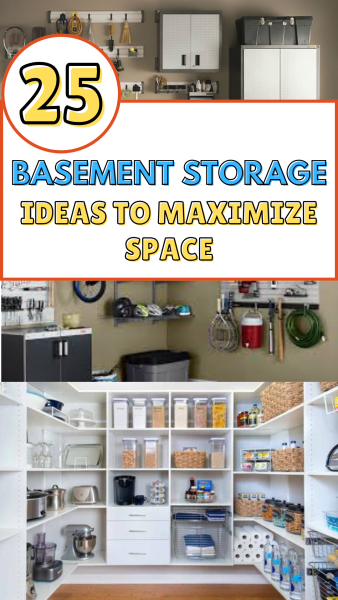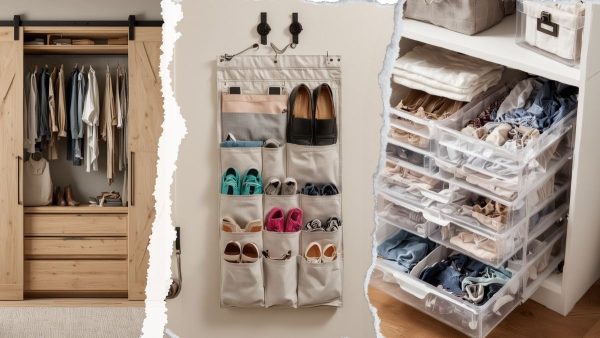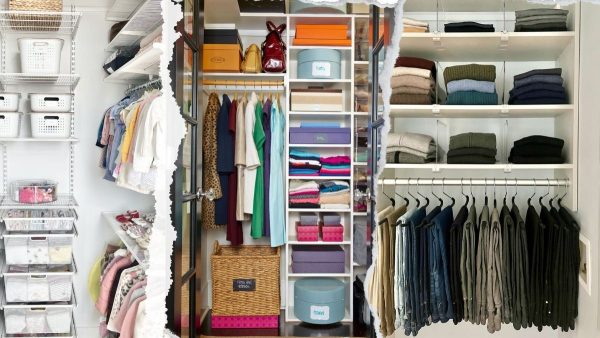When I set out to transform my basement, I quickly realized the potential it held for inventive storage solutions.
Basements can often be overlooked and underutilized, but with a touch of creativity, they can become effective and organized spaces.

Through trial and error, I found 25 innovative ideas that changed my cluttered basement into a functional storage haven.
Let’s dive in!
1. Utilize Ceiling Space with Overhead Shelving
Install overhead shelving units in your basement to maximize storage space without sacrificing floor area. These shelves are ideal for storing seasonal items like holiday decorations and camping gear.
Ensure the shelves are securely attached to the ceiling joists to support the weight of the items. Using clear, labeled bins can help you easily see what’s stored and keep everything organized and dust-free.
2. Install Pegboards for Versatile Tool Storage
Pegboards are a great solution for organizing tools and small items in your basement. Mount the pegboard on the wall and use various hooks and attachments to hang tools, gardening equipment, and other small items.
This system keeps your tools visible and within easy reach, reducing the time spent searching for them.
You can also add small baskets or containers to the pegboard to hold nails, screws, and other small hardware, keeping everything neatly organized.
3. Create a Dedicated Pantry Area
Transform a corner of your basement into a dedicated pantry to store bulk food items, canned goods, and kitchen supplies.
Install sturdy shelving units that can hold heavy items and use clear containers or labeled bins to keep everything organized.
This setup frees up space in your kitchen and allows you to buy groceries in bulk and keep them neatly stored.
4. Use Totes for Organized Storage
Clear plastic totes are perfect for basement storage as they allow you to see the contents without opening them.
Use them to store a variety of items such as seasonal decorations, off-season clothing, and craft supplies.
Label each tote with its contents and stack them neatly on shelves or in designated areas to keep everything organized and easily accessible.
5. Build Custom Shelving Units
Custom shelving units can be tailored to fit the specific dimensions and needs of your basement. Use durable materials like plywood or metal to construct shelves that can hold heavy items such as paint cans, tools, and storage bins.
Custom shelving allows you to optimize the use of available space and create storage solutions that perfectly fit your items.
Ensure that the shelves are securely anchored to the walls to prevent tipping and to provide stability.
6. Store Root Vegetables Properly
For those who grow their own produce, setting up a storage system for root vegetables in the basement is essential.
Use bins with ventilation holes to store potatoes, onions, and other root vegetables. Keep these bins in a cool, dark part of the basement to prevent sprouting and decay.
This setup helps preserve the quality of your vegetables for longer periods, allowing you to enjoy home-grown produce well into the winter months.
7. Install a Basement Closet
Creating a closet space in your basement can help you store out-of-season clothing and other items.
Install hanging rods and shelves to maximize the use of vertical space. Use garment bags to protect clothing from dust and moisture.
This setup keeps your seasonal clothes organized and frees up space in your bedroom closets.
Label shelves and bins to make it easy to find and switch out items as needed.
8. Use Free-Standing Metal Shelves
Heavy-duty metal shelves are ideal for storing heavy and bulky items in your basement. These shelves are sturdy and can hold items like paint cans, tools, and storage bins.
Arrange the shelves against walls to maximize floor space and use clear bins or labeled boxes to keep everything organized.
Metal shelves are durable and can withstand the weight of heavy items, making them a reliable storage solution.
9. Designate Zones for Different Items
Organizing your basement into different zones for various types of storage can help keep things tidy and accessible. Create specific areas for sports equipment, seasonal decorations, and household tools.
This method allows you to easily find what you need and keeps related items together. Use shelves, bins, and labels to define each zone and keep everything in its place.
10. Install Sliding Storage Racks
Sliding storage racks are a great solution for making use of narrow spaces in your basement. These racks can be installed along walls and slide out for easy access to stored items.
They are perfect for storing canned goods, small boxes, and other items that need to be kept organized but accessible.
11. Set Up a Wine Cellar
If you’re a wine enthusiast, consider converting a section of your basement into a wine cellar. Install proper wine racks and ensure the area has climate control to maintain the ideal temperature and humidity levels for wine storage.
This setup not only keeps your wine collection organized but also preserves the quality and taste of your wines over time.
However, you should ensure the space is dark and cool to create the perfect environment for wine aging.
12. Create a Crafting Station
For DIY enthusiasts, setting up a crafting station in the basement can be a game-changer. Install a sturdy workbench and use shelves and pegboards to store crafting supplies and tools.
Keep everything organized and within reach to make your crafting projects more enjoyable and efficient.
Use bins and containers to sort smaller items like beads, thread, and fabric scraps. This dedicated space allows you to focus on your projects without cluttering other areas.
13. Install Moisture Barriers
Moisture can be a major issue in basements, potentially damaging stored items. Install vapor barriers on walls and floors to prevent moisture from seeping in. Use dehumidifiers to keep the air dry and reduce the risk of mold and mildew.
This setup helps protect your belongings from moisture damage and creates a healthier environment in your basement.
14. Use Furniture with Built-In Storage
Opt for furniture pieces that come with built-in storage to maximize your basement space. Benches with under-seat compartments, ottomans with hidden storage, and tables with drawers can provide additional storage without taking up extra room.
These multifunctional furniture pieces help keep your basement organized and can also add a decorative touch to the space.
Use these storage solutions to keep frequently used items within easy reach while maintaining a clutter-free environment.
15. Set Up a Laundry Area
If you do laundry in the basement, organizing the space can make the process more efficient.
Install shelves to store detergents, fabric softeners, and other laundry supplies. Use baskets or bins to sort dirty clothes and a folding station to handle clean laundry.
Keep everything organized and within reach to streamline your laundry routine. Consider adding a drying rack or a rod for hanging clothes to air dry.
16. Create a Home Gym Storage
For fitness enthusiasts, designating a part of the basement for a home gym can be very beneficial. Install wall-mounted racks and shelves to store weights, resistance bands, and yoga mats.
Use hooks for items like jump ropes and exercise balls. This setup keeps your workout equipment organized and easily accessible, allowing you to maintain a clutter-free workout space.
17. Store Gardening Supplies
Gardening tools and supplies can often clutter a garage or shed, so dedicating a space in your basement for these items can be very practical.
Install pegboards or hooks to hang tools like shovels, rakes, and trowels. Use shelves and bins for smaller items such as pots, seeds, and soil.
Keeping these supplies organized in the basement protects them from the elements and makes them easy to find when it’s time to garden.
18. Install a Water-Resistant Flooring
Installing water-resistant flooring in your basement can protect your stored items from potential water damage.
Options like vinyl, tile, or epoxy flooring are excellent choices as they can withstand moisture and are easy to clean.
This flooring not only safeguards your belongings but also enhances the overall look of your basement.
19. Use Labeled Bins for Seasonal Items
Organizing seasonal items into clearly labeled bins helps keep your basement tidy and makes it easy to switch out decorations and clothing as the seasons change.
Use different colored bins for different seasons, and label them with their contents. Stack these bins neatly on shelves to save floor space and keep everything accessible.
This system simplifies finding what you need and ensures that items are protected from dust and moisture.
20. Set Up a Library or Reading Nook
Transform a corner of your basement into a cozy reading nook with bookshelves and comfortable seating.
Arrange books by genre or author on the shelves to keep them organized and easy to find.
Add a comfortable chair, good lighting, and perhaps a small table to create a pleasant reading environment.
This dedicated space provides storage for your books and gives you a quiet retreat for reading and relaxation.
21. Hang Bicycles and Sports Gear
Free up floor space by hanging bicycles and sports gear on wall-mounted racks or ceiling hooks. This setup keeps bikes and equipment off the ground, reducing clutter and preventing damage.
Use sturdy hooks and ensure they are properly installed to support the weight of the items.
22. Create a Home Office Space
If you need a quiet place to work from home, setting up a home office in the basement can be a great solution.
Use a sturdy desk and comfortable chair, and install shelves and filing cabinets for office supplies and documents.
This setup creates a productive workspace separate from the main living areas, helping you focus and stay organized.
23. Store Paint and Hazardous Materials Safely
Proper storage of paint, chemicals, and other hazardous materials is crucial for safety. Use metal shelves or cabinets with lockable doors to store these items.
Ensure the storage area is well-ventilated and away from any heat sources.
Clearly label all containers and keep them out of reach of children and pets. Regularly check for leaks or spills and clean them up promptly to prevent accidents.
24. Set Up a Play Area for Kids
Designating a part of the basement as a play area for kids can help keep toys and games organized. Use bins and shelves to store toys, books, and art supplies.
Make sure the play area is safe, with soft flooring and no sharp edges.
This setup not only provides a fun space for kids to play but also keeps their toys from cluttering other parts of the house.
25. Install Energy-Efficient Lighting
Install energy-efficient LED lights to brighten up the space and reduce energy costs. So, you should use a combination of overhead lights and task lighting to ensure all areas are well-lit.
Good lighting makes it easier to see and access stored items, and can also make the basement feel more welcoming and usable.
And finally, you should consider adding motion sensor lights for convenience and to further save energy.

